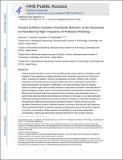Tendon exhibits complex poroelastic behavior at the nanoscale as revealed by high-frequency AFM-based rheology
Author(s)
Connizzo, Brianne K; Grodzinsky, Alan J
Downloadnihms848185.pdf (642.4Kb)
PUBLISHER_CC
Publisher with Creative Commons License
Creative Commons Attribution
Terms of use
Metadata
Show full item recordAbstract
Tendons transmit load from muscle to bone by utilizing their unique static and viscoelastic tensile properties. These properties are highly dependent on the composition and structure of the tissue matrix, including the collagen I hierarchy, proteoglycans, and water. While the role of matrix constituents in the tensile response has been studied, their role in compression, particularly in matrix pressurization via regulation of fluid flow, is not well understood. Injured or diseased tendons and tendon regions that naturally experience compression are known to have alterations in glycosaminoglycan content, which could modulate fluid flow and ultimately mechanical function. While recent theoretical studies have predicted tendon mechanics using poroelastic theory, no experimental data have directly demonstrated such behavior. In this study, we use high-bandwidth AFM-based rheology to determine the dynamic response of tendons to compressive loading at the nanoscale and to determine the presence of poroelastic behavior. Tendons are found to have significant characteristic dynamic relaxation behavior occurring at both low and high frequencies. Classic poroelastic behavior is observed, although we hypothesize that the full dynamic response is caused by a combination of flow-dependent poroelasticity as well as flow-independent viscoelasticity. Tendons also demonstrate regional dependence in their dynamic response, particularly near the junction of tendon and bone, suggesting that the structural and compositional heterogeneity in tendon may be responsible for regional poroelastic behavior. Overall, these experiments provide the foundation for understanding fluid-flow-dependent poroelastic mechanics of tendon, and the methodology is valuable for assessing changes in tendon matrix compressive behavior at the nanoscale. Keywords: Poroelasticity; Viscoelasticity; Tendon; AFM; Nanomechanics
Date issued
2017-01Department
Massachusetts Institute of Technology. Center for Biomedical Engineering; Massachusetts Institute of Technology. Department of Biological Engineering; Massachusetts Institute of Technology. Department of Electrical Engineering and Computer Science; Massachusetts Institute of Technology. Department of Mechanical EngineeringJournal
Journal of Biomechanics
Publisher
Elsevier BV
Citation
Connizzo, Brianne K., and Alan J. Grodzinsky. “Tendon Exhibits Complex Poroelastic Behavior at the Nanoscale as Revealed by High-Frequency AFM-Based Rheology.” Journal of Biomechanics 54 (March 2017): 11–18 © 2017 Elsevier Ltd
Version: Author's final manuscript
ISSN
0021-9290